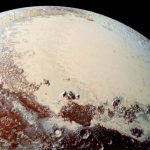
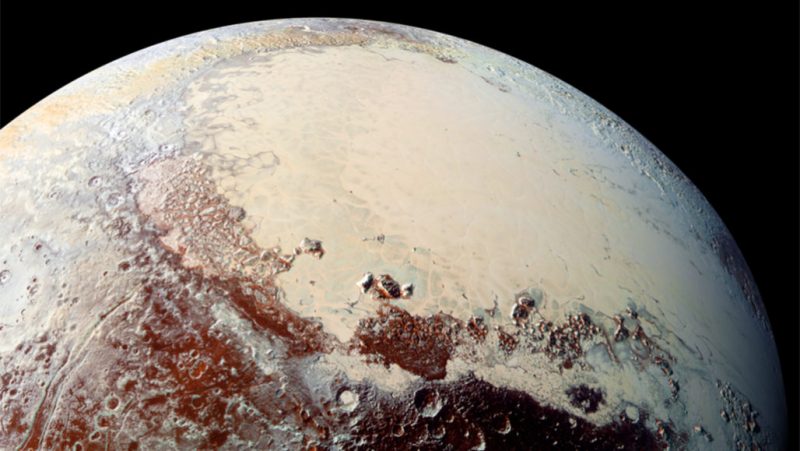
New Horizons’ view of Sputnik Planitia on Pluto, which makes up half of Pluto’s “heart” feature. A new study of odd ripples on the opposite side of the dwarf planet supports previous evidence that Pluto has a subsurface ocean. Image via NASA/ SwRI/ JHUAPL/ Science News.
Not all that long ago, scientists thought that Earth was the only place in the solar system with an ocean. But then we learned – surprise! – that several icy moons in the outer solar system are also water worlds. They’re true water worlds, too, in the sense that most, if not all, of their oceans are global. These alien oceans are different from Earth’s oceans: they’re not on the surfaces of the moons, but below the moons’ surface crusts of ice. Now, evidence is building for yet another such ocean, this time not on a moon but on the dwarf planet Pluto. The evidence is based on what the scientists called “ripples” on Pluto’s surface.
Scientists presented the latest findings about ripples in Pluto’s surface – and a possible ocean below Pluto’s crust – at the virtual 51st Lunar and Planetary Science Conference. The evidence suggests that Pluto has a deep ocean between its crust and core. The conference had been scheduled to be held from March 16-20 in The Woodlands near Houston, Texas, but was changed to a virtual-only format this year due to the COVID-19 pandemic.
This latest update on a possible Plutonian ocean was also the subject of a new article by Theresa Machemer in Smithsonian Magazine on April 1, 2020. The results are based on a new paper that was first pre-published on ArXiv in October 2019, and is still waiting for peer review. Lead author is a name you may recognize. It’s Alan Stern, who spearheaded the New Horizons mission to Pluto for decades, from concept to reality.
The main focus of the new paper was to study the far side terrains of Pluto, and how they formed. From the paper:
The New Horizons spacecraft provided near global observations of Pluto that far exceed the resolution of Earth-based data sets. Most Pluto New Horizons analysis hitherto has focused on the encounter hemisphere of Pluto (i.e., the anti-Charon hemisphere containing Sputnik Planitia). In this work, we summarize and interpret data on the far side (i.e., the non-encounter hemisphere), providing the first integrated New Horizons overview of the far side terrains.

The unusual dark “ripples” on the far side of Pluto (circled). Pluto’s far side was only able to be seen in lower resolution during the New Horizons flyby, but the images still provide valuable clues as to the possibility of a subsurface ocean. Image via New Horizons Team/ Science News.
The evidence for a Pluto ocean comes from dark ripple-like features on the far side of Pluto. How did these ripples form? Scientists think they were produced by the same large impact that created Sputnik Planitia, which is a huge smooth plain of primarily nitrogen ice on the other side of the dwarf planet. This shallow basin composes one half of the distinctive huge “heart” feature on Pluto. As Purdue University planetary scientist Adeene Denton told Lisa Grossman in a statement to Science News:
If the impact is large enough, the planet itself can act like a lens, and focus the wave energy at the exact opposite point on the planet from the impact.
Denton and her colleagues had run computer simulations to see how the shock waves from the impact might have affected Pluto’s interior. The simulations suggested that an ocean was necessary to explain the ripples. As Denton said:
We got the fun answer.
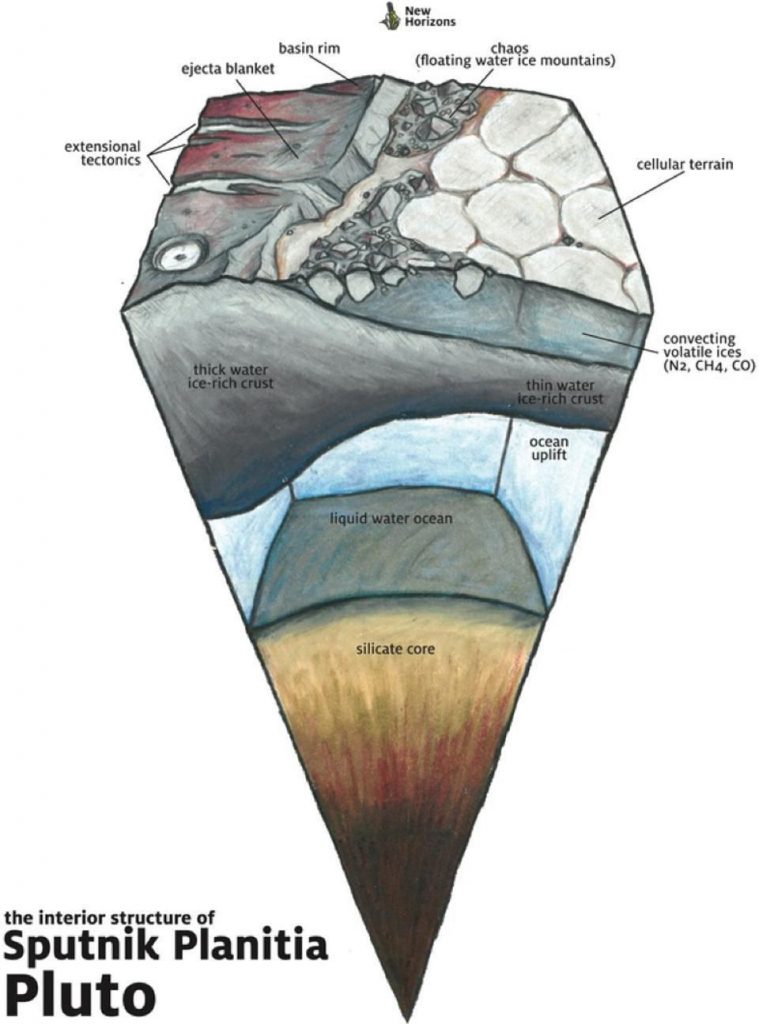
Diagram of what the interior of Pluto might look like below Sputnik Planitia (the cellular terrain on the right side, on top). The ice crust above the water is thinner in this region. Image via James Tuttle Keane/ Medium.com/ Starts With a Bang!.
The ocean would need to be at least 90 miles (150 km) deep, and Pluto’s core must contain minerals, such as serpentine, that form through interactions between rock and water. Denton said:
It’s certainly not exactly a smoking gun. But it’s exciting.
This new modeling of Pluto’s interior is the latest of a growing number of studies suggesting that Pluto could still have liquid water beneath its surface. Previously, in 2016, scientists also showed that fissures on the surface, and the spherical shape of Pluto itself, were evidence for a subsurface ocean. Pluto’s orientation may also be a clue. Another study from last year contends that the rocky body that collided with Pluto and created Sputnik Planitia actually broke through the dwarf planet’s icy crust. This allowed the ocean to briefly flow on the surface before freezing, which affected Pluto’s axis orientation.
The new research is compelling, although not conclusive yet. It’s still possible that there is another explanation for the rippled terrain on the far side. As James Tuttle Keane, a planetary scientist at NASA’s Jet Propulsion Laboratory, told Scientific American in a statement:
There’s a lot of weird stuff on that far side of Pluto. And there are a lot of different ways that you can imagine creating some of those odd patterns that we see.
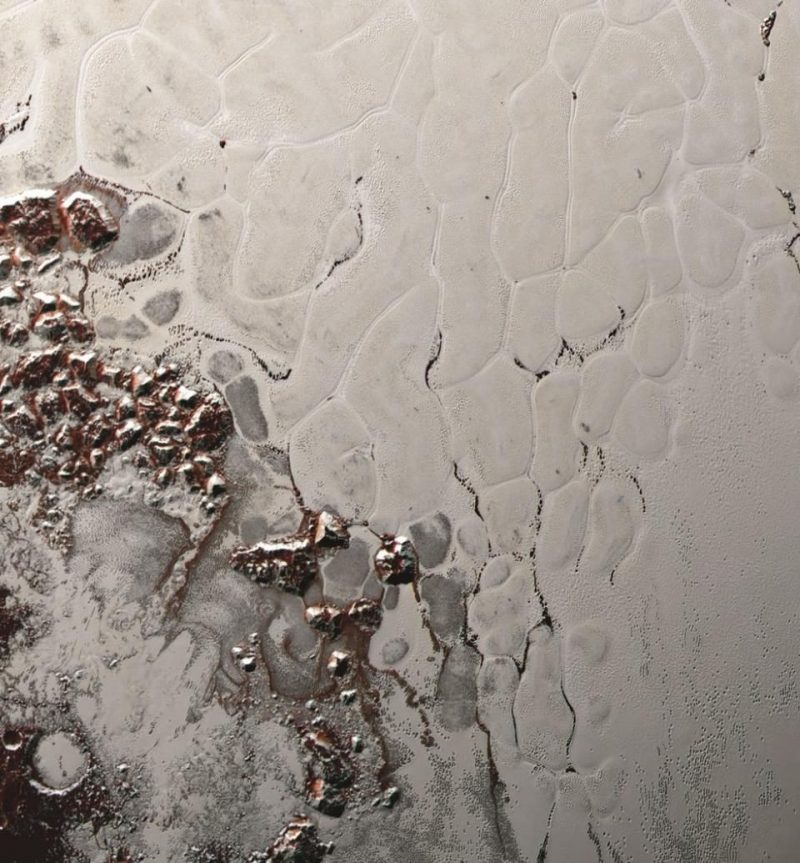
Close-up view of the unusual cellular terrain in Sputnik Planitia, composed of nitrogen ice. Water ice mountains are on the edge of this region. Image via NASA/ JHUAPL/ SwRI/ Medium.com/ Starts With a Bang!.
Whether the newest research really does indicate an ocean on Pluto remains to be seen. But if it does, that would greatly help scientists understand how such subsurface oceans can exist on worlds that are otherwise too cold and too far from the sun, including possibly other small objects in the Kuiper Belt – a ring of small rocky and icy bodies orbiting the sun beyond Neptune – where Pluto resides. As Denton told Scientific American:
We might need to think a little differently about the Kuiper Belt itself and all of these distant worlds in it and maybe look at them a little bit closer. They could all host such incredible, rich geologic histories.
If there really is an ocean on Pluto, then how and when did it form? As planetary scientist Carver Bierson of the University of California, Santa Cruz, told Science News:
If there’s an ocean today, it raises the question of, when did that ocean get there?
According to Bierson, if Pluto had a “cold start,” then the water would have been frozen from the beginning, before melting later on due to decaying radioactive elements in the dwarf planet’s core. It would then partially re-freeze again. But if Pluto had a “warm start,” then the ocean would have always been liquid, and probably still is today, with perhaps only partial re-freezing. Cracks would form from the water partially re-freezing, and this is what the New Horizons images seemed to show. Bierson said:
That means maybe Pluto did start off warm. Maybe it started with a liquid ocean really early on.
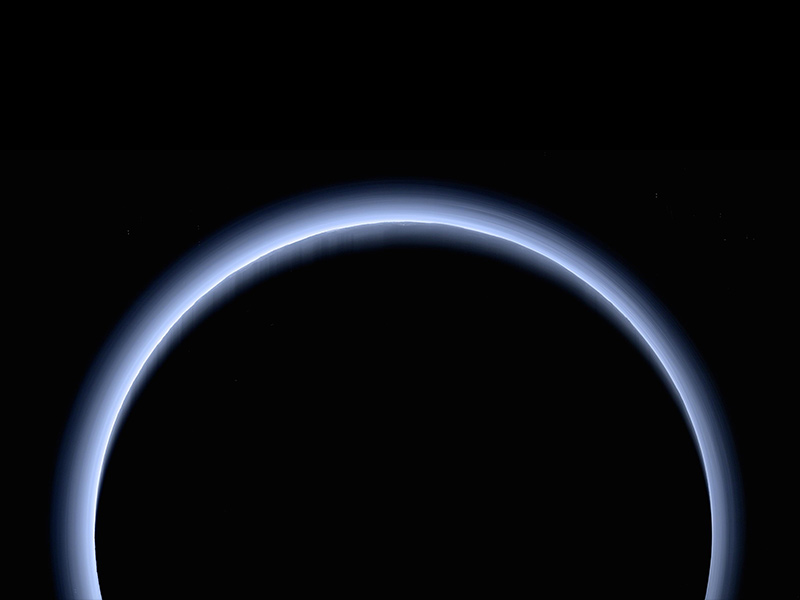
Pluto backlit by the sun, as seen by New Horizons. The thin atmosphere glows an ethereal soft blue color. Image via NASA/ JHUAPL/ SwRI.
So if Pluto has had an ocean for the past few billion years, could it be habitable? Could Pluto’s ocean actually support life? If Pluto’s core does contain minerals as hypothesized, then water-rock interactions at the ocean bottom could conceivably provide the necessary energy and nutrients, as in oceans on Earth and possibly ocean moons like Europa and Enceladus. And if Pluto could be habitable, what about other bodies in the Kuiper Belt? As Keane surmised in Science News:
This lays out one of the coolest hypotheses that a future Pluto mission could test. If Pluto can have an ocean and potentially be habitable, it’s very likely that other bodies in the Kuiper Belt also are ocean worlds and also are potentially habitable.
Although New Horizons’ mission at Pluto is long over, the data sent back will keep researchers busy for decades to come. As noted in Scientific American by Jani Radebaugh, a planetary scientist at Brigham Young University:
It’s amazing how we squeeze every little bit out of it.

Alan Stern of the Southwest Research Institute (SwRI), Principal Investigator of the New Horizons mission to Pluto and lead author of the new study. Image via SwRI.
New Horizons found that Pluto is a complex little world, with vast, smooth icy plains of frozen nitrogen, the surface of which is divided into large “cells” (known as cellular terrain) and mountains composed of water ice with methane “snow” on top. Pluto also has a very thin atmosphere of nitrogen, methane and carbon monoxide, and when New Horizons viewed Pluto backlit by the Sun, the atmosphere glowed softly as a blue ring around the dwarf planet. And even though Pluto is much smaller than Earth, it has no less than five moons! If there is an ocean below as well, that would make this already bizarre world even stranger.
Bottom line: Odd ripples on Pluto’s far side add to the evidence for a subsurface ocean.
from EarthSky https://ift.tt/2K3cJzv


New Horizons’ view of Sputnik Planitia on Pluto, which makes up half of Pluto’s “heart” feature. A new study of odd ripples on the opposite side of the dwarf planet supports previous evidence that Pluto has a subsurface ocean. Image via NASA/ SwRI/ JHUAPL/ Science News.
Not all that long ago, scientists thought that Earth was the only place in the solar system with an ocean. But then we learned – surprise! – that several icy moons in the outer solar system are also water worlds. They’re true water worlds, too, in the sense that most, if not all, of their oceans are global. These alien oceans are different from Earth’s oceans: they’re not on the surfaces of the moons, but below the moons’ surface crusts of ice. Now, evidence is building for yet another such ocean, this time not on a moon but on the dwarf planet Pluto. The evidence is based on what the scientists called “ripples” on Pluto’s surface.
Scientists presented the latest findings about ripples in Pluto’s surface – and a possible ocean below Pluto’s crust – at the virtual 51st Lunar and Planetary Science Conference. The evidence suggests that Pluto has a deep ocean between its crust and core. The conference had been scheduled to be held from March 16-20 in The Woodlands near Houston, Texas, but was changed to a virtual-only format this year due to the COVID-19 pandemic.
This latest update on a possible Plutonian ocean was also the subject of a new article by Theresa Machemer in Smithsonian Magazine on April 1, 2020. The results are based on a new paper that was first pre-published on ArXiv in October 2019, and is still waiting for peer review. Lead author is a name you may recognize. It’s Alan Stern, who spearheaded the New Horizons mission to Pluto for decades, from concept to reality.
The main focus of the new paper was to study the far side terrains of Pluto, and how they formed. From the paper:
The New Horizons spacecraft provided near global observations of Pluto that far exceed the resolution of Earth-based data sets. Most Pluto New Horizons analysis hitherto has focused on the encounter hemisphere of Pluto (i.e., the anti-Charon hemisphere containing Sputnik Planitia). In this work, we summarize and interpret data on the far side (i.e., the non-encounter hemisphere), providing the first integrated New Horizons overview of the far side terrains.

The unusual dark “ripples” on the far side of Pluto (circled). Pluto’s far side was only able to be seen in lower resolution during the New Horizons flyby, but the images still provide valuable clues as to the possibility of a subsurface ocean. Image via New Horizons Team/ Science News.
The evidence for a Pluto ocean comes from dark ripple-like features on the far side of Pluto. How did these ripples form? Scientists think they were produced by the same large impact that created Sputnik Planitia, which is a huge smooth plain of primarily nitrogen ice on the other side of the dwarf planet. This shallow basin composes one half of the distinctive huge “heart” feature on Pluto. As Purdue University planetary scientist Adeene Denton told Lisa Grossman in a statement to Science News:
If the impact is large enough, the planet itself can act like a lens, and focus the wave energy at the exact opposite point on the planet from the impact.
Denton and her colleagues had run computer simulations to see how the shock waves from the impact might have affected Pluto’s interior. The simulations suggested that an ocean was necessary to explain the ripples. As Denton said:
We got the fun answer.

Diagram of what the interior of Pluto might look like below Sputnik Planitia (the cellular terrain on the right side, on top). The ice crust above the water is thinner in this region. Image via James Tuttle Keane/ Medium.com/ Starts With a Bang!.
The ocean would need to be at least 90 miles (150 km) deep, and Pluto’s core must contain minerals, such as serpentine, that form through interactions between rock and water. Denton said:
It’s certainly not exactly a smoking gun. But it’s exciting.
This new modeling of Pluto’s interior is the latest of a growing number of studies suggesting that Pluto could still have liquid water beneath its surface. Previously, in 2016, scientists also showed that fissures on the surface, and the spherical shape of Pluto itself, were evidence for a subsurface ocean. Pluto’s orientation may also be a clue. Another study from last year contends that the rocky body that collided with Pluto and created Sputnik Planitia actually broke through the dwarf planet’s icy crust. This allowed the ocean to briefly flow on the surface before freezing, which affected Pluto’s axis orientation.
The new research is compelling, although not conclusive yet. It’s still possible that there is another explanation for the rippled terrain on the far side. As James Tuttle Keane, a planetary scientist at NASA’s Jet Propulsion Laboratory, told Scientific American in a statement:
There’s a lot of weird stuff on that far side of Pluto. And there are a lot of different ways that you can imagine creating some of those odd patterns that we see.

Close-up view of the unusual cellular terrain in Sputnik Planitia, composed of nitrogen ice. Water ice mountains are on the edge of this region. Image via NASA/ JHUAPL/ SwRI/ Medium.com/ Starts With a Bang!.
Whether the newest research really does indicate an ocean on Pluto remains to be seen. But if it does, that would greatly help scientists understand how such subsurface oceans can exist on worlds that are otherwise too cold and too far from the sun, including possibly other small objects in the Kuiper Belt – a ring of small rocky and icy bodies orbiting the sun beyond Neptune – where Pluto resides. As Denton told Scientific American:
We might need to think a little differently about the Kuiper Belt itself and all of these distant worlds in it and maybe look at them a little bit closer. They could all host such incredible, rich geologic histories.
If there really is an ocean on Pluto, then how and when did it form? As planetary scientist Carver Bierson of the University of California, Santa Cruz, told Science News:
If there’s an ocean today, it raises the question of, when did that ocean get there?
According to Bierson, if Pluto had a “cold start,” then the water would have been frozen from the beginning, before melting later on due to decaying radioactive elements in the dwarf planet’s core. It would then partially re-freeze again. But if Pluto had a “warm start,” then the ocean would have always been liquid, and probably still is today, with perhaps only partial re-freezing. Cracks would form from the water partially re-freezing, and this is what the New Horizons images seemed to show. Bierson said:
That means maybe Pluto did start off warm. Maybe it started with a liquid ocean really early on.

Pluto backlit by the sun, as seen by New Horizons. The thin atmosphere glows an ethereal soft blue color. Image via NASA/ JHUAPL/ SwRI.
So if Pluto has had an ocean for the past few billion years, could it be habitable? Could Pluto’s ocean actually support life? If Pluto’s core does contain minerals as hypothesized, then water-rock interactions at the ocean bottom could conceivably provide the necessary energy and nutrients, as in oceans on Earth and possibly ocean moons like Europa and Enceladus. And if Pluto could be habitable, what about other bodies in the Kuiper Belt? As Keane surmised in Science News:
This lays out one of the coolest hypotheses that a future Pluto mission could test. If Pluto can have an ocean and potentially be habitable, it’s very likely that other bodies in the Kuiper Belt also are ocean worlds and also are potentially habitable.
Although New Horizons’ mission at Pluto is long over, the data sent back will keep researchers busy for decades to come. As noted in Scientific American by Jani Radebaugh, a planetary scientist at Brigham Young University:
It’s amazing how we squeeze every little bit out of it.

Alan Stern of the Southwest Research Institute (SwRI), Principal Investigator of the New Horizons mission to Pluto and lead author of the new study. Image via SwRI.
New Horizons found that Pluto is a complex little world, with vast, smooth icy plains of frozen nitrogen, the surface of which is divided into large “cells” (known as cellular terrain) and mountains composed of water ice with methane “snow” on top. Pluto also has a very thin atmosphere of nitrogen, methane and carbon monoxide, and when New Horizons viewed Pluto backlit by the Sun, the atmosphere glowed softly as a blue ring around the dwarf planet. And even though Pluto is much smaller than Earth, it has no less than five moons! If there is an ocean below as well, that would make this already bizarre world even stranger.
Bottom line: Odd ripples on Pluto’s far side add to the evidence for a subsurface ocean.
from EarthSky https://ift.tt/2K3cJzv

Aucun commentaire:
Enregistrer un commentaire